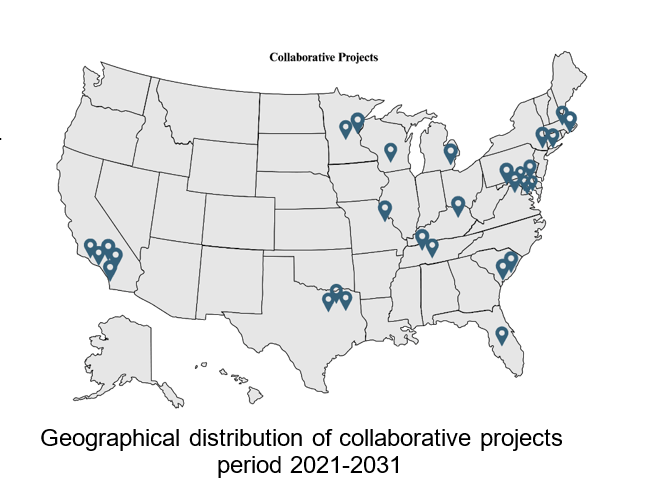
To properly perform modern MRI and MRS of disease and develop biomarkers that can ultimately contribute to personalized medicine, it is of essence to combine the expertise of physicists, translational scientists, and clinicians. It is fair to say that it is almost impossible for a single scientist to perform all aspects of such complex research. MRI is uniquely suited to translate newly developed methodologies directly to patient care. However, this does not always happen because of lack of interaction between basic scientists and clinicians or an improper understanding of clinical needs by the physicists and engineers. Our proposed Center is dedicated to translating the new biomarker technology into clinical practice. For this we need close collaboration with leading clinicians and scientists throughout the nation (see map). With this in mind, the recruitment criteria for a collaborative project are that the NIH-funded investigators study diseases for which our technology is expected to be beneficial and who can provide expert feedback leading to new ideas that can further our technologies with the purpose of better assessing multiple disease aspects. If you are interested in becoming a collaborative project, please apply to Dr. van Zijl or Dr. Lu.
Our Collaborative Projects since 2021 are (ordered chronologically) below: (“newCP” relates to projects for the period 2026-2031):
- Cerebrovascular reserve and white matter disease in patients with anemia
John Wood, Children's Hospital of Los Angeles - Dallas lifespan brain study-wave 3: neurodegeneration & resilience in cognition
Denise Park, University of Texas, Dallas - 2/21 ABCD-USA Consortium: Research Project Site at UMB
Linda Chang and Thomas Ernst, University of Maryland Baltimore (UMB) - Subtle motor functioning and functional connectivity in youth medically cleared after mild TBI
Stacy Suskauer, Kennedy Krieger Institute - Mechanisms of age-related white matter hyperintensities (WMHs): insights from advanced MRI
Yulin Ge, New York University - Quantitative imaging of brain glymphatic function in humans
Manus Donahue, Vanderbilt University - Preclinical Alzheimer’s Disease (AD) consortium
Marilyn Albert, Johns Hopkins University - University of Michigan fibromyalgia (FM) CORT. Pain Mechanisms
Richard Harris, University of Michigan at Ann Arbor - Imaging framework for testing GABAergic/glutamatergic drugs in bipolar alcoholics
James Prisciandaro, Medical University of S. Carolina - Contributions of Alzheimer's pathology and cerebrovascular factors to cognitive aging
Brian Gold, University of Kentucky - Center for the Study of Aphasia Recovery (C-STAR)
Julius Fridriksson, Medical University of South Carolina
Argye Hillis, Johns Hopkins University, Baltimore - Healthy Brain and Child Development National Consortium
Jessica Wisnowski, Children's Hospital of Los Angeles. - Healthy Brain and Child Development National Consortium
Heather Volk, Johns Hopkins University, Baltimore
Andrew Satin, Johns Hopkins University, Baltimore
James Pekar, Kennedy Krieger Institute, Baltimore - Healthy Brain and Child Development National Consortium
Christopher Smyser, Washington University
Anders Dale, UC San Diego
Damian Fair, University of Minnesota, Minneapolis - Immune dynamics shaping blood brain barrier integrity in virally suppressed people with HIV
Jennifer Coughlin and Leah Rubin, Johns Hopkins University, Baltimore - VCID Biomarkers Coordinating Center
Steven Greenberg, Massachusetts General Hospital, Boston - newCP2: Imaging Neurodegeneration in Multiple Sclerosis
Peter Calabresi and Shiv Saidha, Johns Hopkins University, Baltimore - newCP3: Cerebral Energy Metabolism in ME/CFS with and without PASC
Xiang Xu, Mount Sinai, New York - newCP10: WISE II - Obesity and Type-2 Diabetes: Bariatric Surgery Effects on Brain Function
Eric Porges, University of Florida, Gainesville - newCP1: Personalized hemodynamic and metabolic signatures of revascularization response in moyamoya disease
Manus Donahue, Vanderbilt University - newCP4: Cerebrovascular reactivity as a VCID biomarker in CADASIL
Jill Barnes, University of Wisconsin, Madison - newCP5: A Novel Wavelet Neurovascular Bundle for Real Time Detection of Injury in Neonatal Encephalopathy
Lina Chalak, University of Texas, Southwestern, Dallas - newCP6: BRAIN Technology Integration and Dissemination Resource for Ultra-High Gradient Magnetic Resonance Imaging of Human Brain Circuits Across Scales
Susie Huang, Massachusetts General Hospital, Boston - newCP7: Neural Basis of Language in Acute Stroke and Recovery
Argye Hillis, Johns Hopkins University, Baltimore - newCP8: Quantitative molecular MR-PET imaging of glycolysis in glioblastoma (GBM)
Benjamin Ellingson, PhD, UCLA, Los Angeles - newCP9: Brain blood flow, oxygenation, and cognition in adult onset iron deficiency anemia (IDA)
John Wood, Children's Hospital of Los Angeles - newCP11: Resource for Molecular Imaging Agents in Precision Medicine
Martin Pomper, University of Texas, Southwestern, Dallas - newCP12: Technology to Realize the Full Potential of UHF MRI
Gregory Metzger, Kamil Ugurbil, University of Minnesota, Minneapolis - newCP13: Development and Translation of D-glucose as a Diagnostic Agent for MRI of Cancer
Peter van Zijl & Linda Knutsson, Kennedy Krieger Institute, Baltimore
